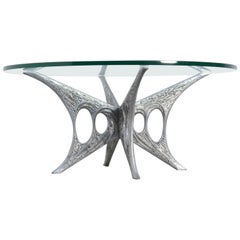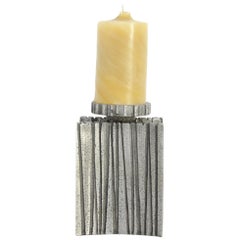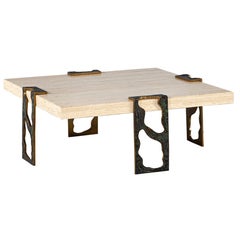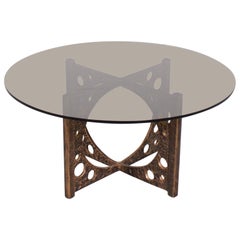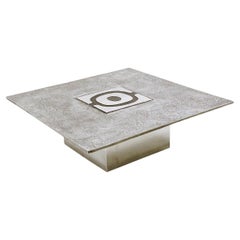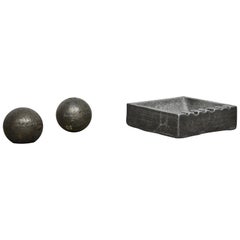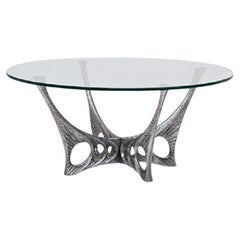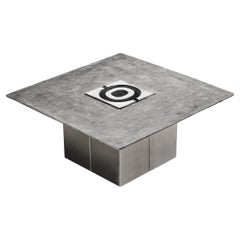Willy Ceysens
Willy Ceysens was a Belgian contemporary and brutalist artist, who created aluminum sculptures and design objects. He predominantly used bronzed aluminum and glass as the medium for his artwork.
| Average Sold Price |
| $210 |
| Styles |
| Materials |
| Related Creators |
Sculptural Coffee Table by Willy Ceysens
Located in Vlimmeren, BE
This aluminum coffee table is a nice example of the Brutalist work of the Belgian artist Willy Ceysens.
It is a unique piece, number 17.
The base is handmade of 2 pieces of cast al...
Category
1960s Belgian Brutalist Vintage Willy Ceysens
Materials
Aluminum
Willy Ceysens Brutalist Aluminium Candle Holder
Located in Vlimmeren, BE
This candle holder was created by Willy Ceysens (1929-2007) in the 1960s.
Willy Ceysens was a Belgian artist who created abstract aluminium sculptures and design objects in the 1960...
Category
1960s Belgian Mid-Century Modern Vintage Willy Ceysens
Materials
Aluminum
Vintage Travertine Cocktail Table with Bronze Accents by Willy Ceysens
Located in North York, ON
This vintage travertine cocktail table is a classic piece of modern brutalist style furniture, designed by Willy Ceysens and crafted in Belgium during the 1970s. Composed of traverti...
Category
1970s Belgian Brutalist Vintage Willy Ceysens
Materials
Travertine, Marble, Metal, Bronze
Brutalist Coffee Table by Willy Ceysens, Belgium, 1960s
Located in Echt, NL
Brutalist coffee table in very good condition.
Designed by Willy Ceysens, Belgium, 1960s
The Brutalist base of this table is made from cast aluminum and has bronze finish.
The rou...
Category
20th Century Belgian Brutalist Willy Ceysens
Materials
Metal, Aluminum
Belgian Coffee Table by Willy Ceysens, Aluminium Cast, 1970s
Located in Brussels, BE
Belgian coffee table by Willy Ceysens, Aluminium Cast, 1970s.
Category
1970s Belgian Mid-Century Modern Vintage Willy Ceysens
Materials
Aluminum
Ashtray Willy Ceysens for Aris, 1950s
By Aris
Located in bruxelles, BE
Brutalist set composed of an ashtray, a paper press and a candleholder in cast aluminium.
Category
1950s Belgian Mid-Century Modern Vintage Willy Ceysens
Materials
Aluminum
Willy Ceysens Exceptional Coffee Table with glass table top
Located in Antwerpen, Antwerp
Rare willy ceysens exceptional coffee table.
Category
1970s Belgian Modern Vintage Willy Ceysens
Materials
Metal
Willy Ceysens Coffee Table in Cast Aluminium
Located in Waalwijk, NL
Willy Ceysens, coffee table, cast aluminium, stainless steel, Belgium, 1970s
Alluring coffee table designed by Willy Ceysens. This remarkable item is a true eye catcher with its out...
Category
1970s Belgian Mid-Century Modern Vintage Willy Ceysens
Materials
Aluminum, Stainless Steel
Browse all Furniture from Willy Ceysens
Shop NowWilly Ceysens Sale Prices
This data represents a recent sample of sales made on 1stDibs during the specified years. All sales are anonymized.
| Sold Date | Sold Price | Category | Material | Creation Year | |
|
| $210 |
Average sold price of items in the past 12 months |
| $210-$210 |
| Sold price range of items in the past 12 months |
Creators Similar to Willy Ceysens
Willy Ceysens furniture for sale on 1stDibs.
Willy Ceysens furniture are available for sale on 1stDibs. These distinctive items are frequently made of metal and are designed with extraordinary care. There are many options to choose from in our collection of Willy Ceysens furniture, although gray editions of this piece are particularly popular. Many of the original furniture by Willy Ceysens were created in the mid-century modern style in europe during the 20th century. If you’re looking for additional options, many customers also consider furniture by Mobichalet, Peter Van Heeck, and Etienne Allemeersch. Prices for Willy Ceysens furniture can differ depending upon size, time period and other attributes — on 1stDibs, these items begin at $324 and can go as high as $19,650, while a piece like these, on average, fetch $2,663.
